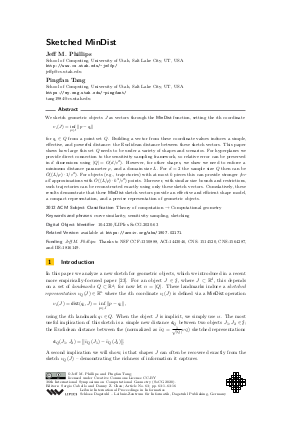Sketched MinDist
Authors Jeff M. Phillips, Pingfan Tang
-
Part of:
Volume:
36th International Symposium on Computational Geometry (SoCG 2020)
Part of: Series: Leibniz International Proceedings in Informatics (LIPIcs)
Part of: Conference: Symposium on Computational Geometry (SoCG) - License:
 Creative Commons Attribution 3.0 Unported license
Creative Commons Attribution 3.0 Unported license
- Publication Date: 2020-06-08
File

PDF
LIPIcs.SoCG.2020.63.pdf
- Filesize: 0.99 MB
- 16 pages
Document Identifiers
Related Versions
-
available at https://arxiv.org/abs/1907.02171.
Subject Classification
ACM Subject Classification
- Theory of computation → Computational geometry
Keywords
- curve similarity
- sensitivity sampling
- sketching
Metrics
- Access Statistics
-
Total Accesses (updated on a weekly basis)
0Document
0Metadata
Abstract
We sketch geometric objects J as vectors through the MinDist function, setting the i-th coordinate v_i(J) = inf_{p ∈ J} ‖p-q_i‖ for q_i ∈ Q from a point set Q. Building a vector from these coordinate values induces a simple, effective, and powerful distance: the Euclidean distance between these sketch vectors. This paper shows how large this set Q needs to be under a variety of shapes and scenarios. For hyperplanes we provide direct connection to the sensitivity sampling framework, so relative error can be preserved in d dimensions using |Q| = O(d/ε²). However, for other shapes, we show we need to enforce a minimum distance parameter ρ, and a domain size L. For d=2 the sample size Q then can be Õ((L/ρ) ⋅ 1/ε²). For objects (e.g., trajectories) with at most k pieces this can provide stronger for all approximations with Õ((L/ρ)⋅ k³ / ε²) points. Moreover, with similar size bounds and restrictions, such trajectories can be reconstructed exactly using only these sketch vectors. Cumulatively, these results demonstrate that these MinDist sketch vectors provide an effective and efficient shape model, a compact representation, and a precise representation of geometric objects.
Cite As Get BibTex
Jeff M. Phillips and Pingfan Tang. Sketched MinDist. In 36th International Symposium on Computational Geometry (SoCG 2020). Leibniz International Proceedings in Informatics (LIPIcs), Volume 164, pp. 63:1-63:16, Schloss Dagstuhl – Leibniz-Zentrum für Informatik (2020)
https://doi.org/10.4230/LIPIcs.SoCG.2020.63
BibTex
@InProceedings{phillips_et_al:LIPIcs.SoCG.2020.63,
author = {Phillips, Jeff M. and Tang, Pingfan},
title = {{Sketched MinDist}},
booktitle = {36th International Symposium on Computational Geometry (SoCG 2020)},
pages = {63:1--63:16},
series = {Leibniz International Proceedings in Informatics (LIPIcs)},
ISBN = {978-3-95977-143-6},
ISSN = {1868-8969},
year = {2020},
volume = {164},
editor = {Cabello, Sergio and Chen, Danny Z.},
publisher = {Schloss Dagstuhl -- Leibniz-Zentrum f{\"u}r Informatik},
address = {Dagstuhl, Germany},
URL = {https://drops.dagstuhl.de/entities/document/10.4230/LIPIcs.SoCG.2020.63},
URN = {urn:nbn:de:0030-drops-122218},
doi = {10.4230/LIPIcs.SoCG.2020.63},
annote = {Keywords: curve similarity, sensitivity sampling, sketching}
}
Author Details
Funding
- Phillips, Jeff M.: Thanks to NSF CCF-1350888, ACI-1443046, CNS- 1514520, CNS-1564287, and IIS-1816149.
References
- Ann Arbor Algorithms. K-graph. Technical report, https://github.com/aaalgo/kgraph, 2018. URL: https://github.com/aaalgo/kgraph.
-
Nina Amenta, Sunghee Choi, and Ravi Krishna Kolluri. The power crust. In Proceedings of the sixth ACM symposium on Solid modeling and applications, 2001.

-
Martin Anthony and Peter L. Bartlett. Neural Network Learning: Theoretical Foundations. Cambridge University Press, 1999.

-
Christos Boutsidis, Michael W Mahoney, and Petros Drineas. An improved approximation algorithm for the column subset selection problem. In Proceedings of the 20th Annual ACM-SIAM Symposium on Discrete Algorithms, 2009.

- Vladimir Braverman, Dan Feldman, and Harry Lang. New frameworks for offline and streaming coreset constructions, 2016. URL: http://arxiv.org/abs/1612.00889.
- Frederic Chazal and David Cohen-Steiner. Geometric inference. URL: https://geometrica.saclay.inria.fr/team/Fred.Chazal/papers/GeomInference5.pdf.
-
Frederic Chazal, David Cohen-Steiner, and Andre Lieutier. A sampling theory for compact sets in euclidean space. DCG, 41:461-479, 2009.

-
Frédéric Chazal, David Cohen-Steiner, and Quentin Mérigot. Geometric inference for probability measures. Foundations of Computational Mathematics, pages 1-19, 2010.

-
Frédéric Chazal and Andre Lieutier. The "λ-medial axis". Graphical Models, 67:304-331, 2005.

-
Michael B. Cohen, Cameron Musco, and Christopher Musco. Input sparsity time low-rank approximation via ridge leverage score sampling. In ACM-SIAM Symposium on Discrete Algorithms, 2017.

-
Michael B. Cohen, Cameron Musco, and Jakub Pachocki. Online row sampling. In International Workshop on Approximation, Randomization, and Combinatorial Optimization, 2016.

-
Anne Driemel, Jeff M. Phillips, and Ioannis Psarros. On the vc dimension of metric balls under frechet and hausdorff distances. In International Symposium on Computational Geometry, 2019.

-
Petros Drineas, Malik Magdon-Ismail, Michael W. Mahoney, and David P. Woodruff. Fast approximation of statistical leverage. Journal of Machine Learning Research, 13:3475-3506, 2012.

-
Petros Drineas, Michael W. Mahoney, and S. Muthukrishnan. Relative-error CUR matrix decompositions. SIAM Journal of MAtrix Analysis and Applications, 30:844-881, 2008.

-
Herbert Edelsbrunner and Ernst P. Mücke. Three-dimensional alpha shapes. ACM Transactions on Graphics, 13:43-72, 1994.

-
Dan Feldman and Michael Langberg. A unified framework for approximating and clustering data. In Proceedings ACM Symposium on Theory of Computing, 2011.

-
Dan Feldman, Melanie Schmidt, and Christian Sohler. Turning big data into tiny data: Constant-size coresets for k-means, PCA, and projective clustering. In Proceedings 24th ACM-SIAM Symposium on Discrete Algorithms, 2013.

-
Dan Feldman and Lenard J. Schulman. Data reduction for weighted and outlier-resistant clustering. In Proc. ACM-SIAM Symposium on Discrete Algorithms, 2012.

-
S. Har-Peled. Geometric Approximation Algorithms. Mathematical Surveys and Monographs. American Mathematical Society, 2011.

-
Michael Langberg and Leonard J. Schulman. Universal ε-approximators for integrals. In SODA, pages 598-607, 2010.

- Michael Matheny, Dong Xie, and Jeff M. Phillips. Scalable spatial scan statistics for trajectories, 2019. URL: http://arxiv.org/abs/1906.01693.
-
Cameron Musco and Christopher Musco. Recursive sampling for the Nyström method. In NIPS, 2017.

- Jeff M. Phillips and Pingfan Tang. Simple distances for trajectories via landmarks. In SIGSPATIAL. (long version: https://arxiv.org/abs/1804.11284), 2019. URL: https://arxiv.org/abs/1804.11284.
-
Jeff M. Phillips, Bei Wang, and Yan Zheng. Geomtric inference on kernel density estimates. In SOCG, 2015.

- Ilya Razenshteyn and Ludwig Schmidt. Falconn-fast lookups of cosine and other nearest neighbors. https://falconn-lib.org, 2018. URL: https://falconn-lib.org.
- Kasturi Varadarajan and Xin Xiao. On the sensitivity of shape fitting problems. In Deepak D'Souza, Telikepalli Kavitha, and Jaikumar Radhakrishnan, editors, IARCS Annual Conference on Foundations of Software Technology and Theoretical Computer Science (FSTTCS 2012), pages 486-497, Dagstuhl, Germany, 2012. Schloss Dagstuhl-Leibniz-Zentrum für Informatik. URL: https://doi.org/10.4230/LIPIcs.FSTTCS.2012.486.
